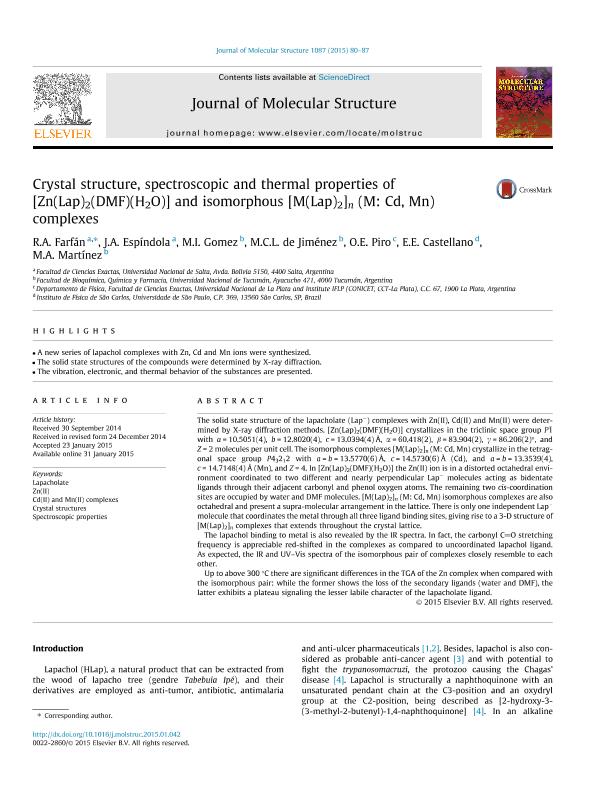Artículo
Crystal structure, spectroscopic and thermal properties of [Zn(Lap)2(DMF)(H2O)] and isomorphous [M(Lap)2]n (M: Cd, Mn) complexes
Farfán, Ramón Antonio; Espíndola, J. A.; Gómez, María Inés; De Jiménez, M. C .L.; Piro, Oscar Enrique ; Castellano, E. E.; Martínez, M. A.
; Castellano, E. E.; Martínez, M. A.
 ; Castellano, E. E.; Martínez, M. A.
; Castellano, E. E.; Martínez, M. A.
Fecha de publicación:
05/2015
Editorial:
Elsevier Science
Revista:
Journal of Molecular Structure
ISSN:
0022-2860
Idioma:
Inglés
Tipo de recurso:
Artículo publicado
Clasificación temática:
Resumen
The solid state structure of the lapacholate (Lap-) complexes with Zn(II), Cd(II) and Mn(II) were determined by X-ray diffraction methods. [Zn(Lap)2(DMF)(H2O)] crystallizes in the triclinic space group P1¯ with a = 10.5051(4), b = 12.8020(4), c = 13.0394(4) Å, α = 60.418(2), β = 83.904(2), γ = 86.206(2)°, and Z = 2 molecules per unit cell. The isomorphous complexes [M(Lap)2]n (M: Cd, Mn) crystallize in the tetragonal space group P43212 with a = b = 13.5770(6) Å, c = 14.5730(6) Å (Cd), and a = b = 13.3539(4), c = 14.7148(4) Å (Mn), and Z = 4. In [Zn(Lap)2(DMF)(H2O)] the Zn(II) ion is in a distorted octahedral environment coordinated to two different and nearly perpendicular Lap- molecules acting as bidentate ligands through their adjacent carbonyl and phenol oxygen atoms. The remaining two cis-coordination sites are occupied by water and DMF molecules. [M(Lap)2]n (M: Cd, Mn) isomorphous complexes are also octahedral and present a supra-molecular arrangement in the lattice. There is only one independent Lap- molecule that coordinates the metal through all three ligand binding sites, giving rise to a 3-D structure of [M(Lap)2]n complexes that extends throughout the crystal lattice. The lapachol binding to metal is also revealed by the IR spectra. In fact, the carbonyl CO stretching frequency is appreciable red-shifted in the complexes as compared to uncoordinated lapachol ligand. As expected, the IR and UV-Vis spectra of the isomorphous pair of complexes closely resemble to each other. Up to above 300 °C there are significant differences in the TGA of the Zn complex when compared with the isomorphous pair: while the former shows the loss of the secondary ligands (water and DMF), the latter exhibits a plateau signaling the lesser labile character of the lapacholate ligand.
Archivos asociados
Licencia
Identificadores
Colecciones
Articulos(IFLP)
Articulos de INST.DE FISICA LA PLATA
Articulos de INST.DE FISICA LA PLATA
Citación
Farfán, Ramón Antonio; Espíndola, J. A.; Gómez, María Inés; De Jiménez, M. C .L.; Piro, Oscar Enrique; et al.; Crystal structure, spectroscopic and thermal properties of [Zn(Lap)2(DMF)(H2O)] and isomorphous [M(Lap)2]n (M: Cd, Mn) complexes; Elsevier Science; Journal of Molecular Structure; 1087; 5-2015; 80-87
Compartir
Altmétricas



